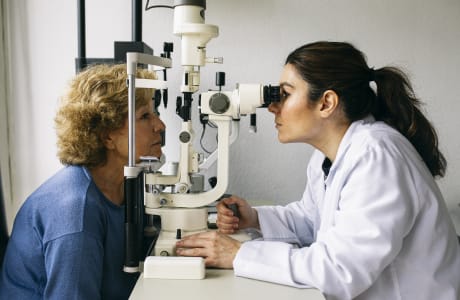Healthwise
Our Health Library information does not replace the advice of a doctor. Please be advised that this information is made available to assist our patients to learn more about their health. Our providers may not see and/or treat all topics found herein.
Topic Contents
Glaucoma Screening
Overview

If you are younger than 40 and have no known risk factors for glaucoma, the American Academy of Ophthalmology (AAO) recommends that you have a complete eye exam every 5 to 10 years. This includes tests that check for glaucoma.footnote 1
If you are at risk for glaucoma, the AAO suggests that you have complete eye exams according to the schedule below:
- Under the age of 40, every 2 to 5 years
- Ages 40 to 54, every 1 to 3 years
- Ages 55 to 64, every 1 to 2 years
- Ages 65 and older, every 1 to 2 years
Your eye doctor may advise you to have eye exams more often, depending on your level of risk and your overall eye health.
People at higher risk for glaucoma include those who:footnote 2
- Are middle-aged and older. The chance of getting glaucoma gets higher as you age, especially after age 40.
- Have a family history of glaucoma.
- Have high eye pressure (high intraocular pressure).
- Are African Americans (for open-angle glaucoma).
- Are East Asians and people with East Asian ancestry (for closed-angle glaucoma).
- Are farsighted (greater risk for getting closed-angle glaucoma).
- Have had an eye injury or eye surgery, such as cataract surgery.
- Have diabetes.
- Have high blood pressure (hypertension).
- Have been taking corticosteroid medicines.
Because people with glaucoma may have normal pressures in their eyes, measuring eye pressure (tonometry) shouldn't be used as the only test for glaucoma. It needs to be combined with other tests before glaucoma can be diagnosed.
After reviewing all of the research, the U.S. Preventive Services Task Force (USPSTF) hasn't recommended for or against routine glaucoma screening for all adults.footnote 3
Related Information
References
Citations
- American Academy of Ophthalmology (2021). Comprehensive Adult Medical Eye Evaluation (Preferred Practice Pattern). Ophthalmology, 128(1): PP1-P29. DOI:10.1016/j.ophtha.2020.10.024. Accessed May 17, 2022.
- American Academy of Ophthalmology (2020). Primary Open Angle Glaucoma (Preferred Practice Pattern). Ophthalmology, 128(1): 71–150. DOI: 10.1016/j.ophtha.2020.10.022. Accessed October 13, 2021.
- U.S. Preventive Services Task Force (2013). Screening for glaucoma. U.S. Preventive Services Task Force. http://www.uspreventiveservicestaskforce.org/uspstf/uspsglau.htm. Accessed November 26, 2013.
Credits
Current as of: October 1, 2025
Author: Ignite Healthwise, LLC Staff
Clinical Review Board
All Ignite Healthwise, LLC education is reviewed by a team that includes physicians, nurses, advanced practitioners, registered dieticians, and other healthcare professionals.
Current as of: October 1, 2025
Author: Ignite Healthwise, LLC Staff
Clinical Review Board
All Ignite Healthwise, LLC education is reviewed by a team that includes physicians, nurses, advanced practitioners, registered dieticians, and other healthcare professionals.
This information does not replace the advice of a doctor. Ignite Healthwise, LLC disclaims any warranty or liability for your use of this information. Your use of this information means that you agree to the Terms of Use and Privacy Policy. Learn how we develop our content.
To learn more about Ignite Healthwise, LLC, visit webmdignite.com.
© 2024-2025 Ignite Healthwise, LLC.



